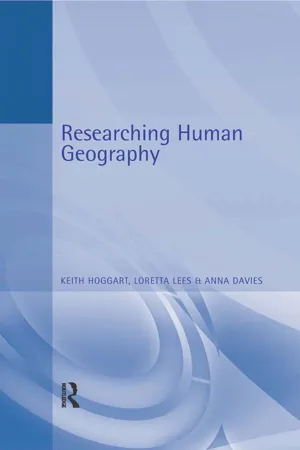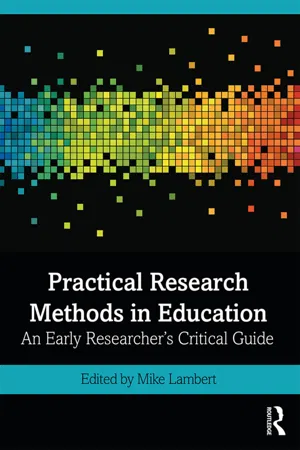Social Sciences
Observation
Observation in social sciences refers to the systematic process of watching, listening, and noting behaviors, events, or phenomena to gather data and gain insights. It involves the objective recording of information without direct interference or manipulation. Observations can be conducted in natural settings or controlled environments and are essential for understanding social interactions, behaviors, and cultural practices.
Written by Perlego with AI-assistance
Related key terms
Related key terms
1 of 4
Related key terms
1 of 3
11 Key excerpts on "Observation"
- eBook - ePub
Practical Social Investigation
Qualitative and Quantitative Methods in Social Research
- Richard Lampard, Christopher Pole(Authors)
- 2015(Publication Date)
- Routledge(Publisher)
Observation: looking to learnIntroduction
In many respects, Observation is something which we all constantly experience as part and parcel of our daily lives. In all of our everyday interactions with people at home, in work, at university or college, in social settings and in formal situations, we observe and make judgements which inform our opinions and our actions, both in relation to and beyond those interactions. We may be part of what we observe, actively contributing to the social action as it is created and evolves around us, or we may be more distanced from it, looking in from the margins or from a greater distance on events upon which we can have no influence.From the outset, therefore, we may assert that Observation is something with which we are all familiar; we do it all the time in order to go about our ordinary and not so ordinary lives. However, in the context of social research, to speak of Observation merely in terms of what can been seen, is to neglect many of the different facets of Observation, which frequently involves a comprehensive and multi-faceted approach to data collection. Rather than merely watching we would prefer to define Observation in terms of experiencing social phenomena at first hand. In this sense, Observation is about being there. It can be as much about hearing, feeling, enjoying, fearing, interpreting, talking and sharing as it is about watching. In this wider definition, therefore, Observation is for all those researchers who have the capacity and the opportunity to be there, and to experience events, institutions, people and places at first hand as they happen.Types of Observation
Traditionally, research methods texts have drawn distinctions between different kinds of Observation based on the degree to which the researcher participates in the activities being observed. The most frequently cited of these texts is that by Gold (1958) who identifies four different kinds of Observation ranging from situations where the researcher is primarily a participant and the data collection is covert (Complete Participant) to situations of surveillance (Complete Observer) where interaction with those being observed is kept to a minimum and may involve the use of cameras and other devices. Between these ends of the spectrum the researcher may adopt approaches where participation is emphasised more than Observation (Participant as Observer) or vice versa (Observer as Participant). Such distinctions are useful in analysing and reflecting on the research process, but in practice can convey little of the complexity of the experience of Observation, whatever the degree of participation involved. - eBook - ePub
Using Research Instruments
A Guide for Researchers
- Peter Birmingham, David Wilkinson(Authors)
- 2003(Publication Date)
- Routledge(Publisher)
Observation, and one of the clearest basic definitions we have found of Observation as a research method tells us that it is ‘research characterised by a prolonged period of intense social interaction between the researcher and the subjects, in the milieu of the latter, during which time data, in the form of field notes, are unobtrusively and systematically collected’ (Bogdan 1972: 3). We refer to social scientific research of this kind throughout this chapter as ‘Observation’, although we make no real distinction between Observation and ‘ethnography’–literally ‘writing about people’. You may come across the term ethnography frequently. It describes essentially the same practice but one which has its roots more in anthropology than in social science.Why choose Observation?
Social researchers are interested in people and, in particular, the ways in which people act in, interpret and understand the complex world around them, whether that is the world of the classroom, the hospital, the factory floor, the head office, the local government department or wherever. How people see and understand their surroundings will no doubt play a part in the ways in which they behave, they act and interact with others, and in the ways their actions are perceived by others. Observation is an extremely handy tool for researchers in this regard. It can allow researchers to understand much more about what goes on in complex real-world situations than they can ever discover simply by asking questions of those who experience them (no matter how probing the questions may be), and by looking only at what is said about them in questionnaires and interviews. This may be because interviewees and questionnaire respondents are sometimes reluctant to impart everything they know, perhaps feeling it would be improper or insensitive to do so, or because they consider some things to be insignificant or irrelevant. It is more likely the case, however, that they are unable - eBook - ePub
Research Methods and Society
Foundations of Social Inquiry
- Linda Eberst Dorsten, Lawrence Hotchkiss(Authors)
- 2018(Publication Date)
- Routledge(Publisher)
detailed Observations. In fact, regularities are often so commonplace that we scarcely notice many actions and reactions—unless something unexpected occurs or we must recall an action. For example, did you ever drive down a street or road so often that you couldn’t tell another person if it has a street name sign posted?The need for detailed Observations of our social world has led to the development of disciplines such as anthropology and sociology, in part to better understand both “the self” and “the other” in everyday life (Vidich and Lyman, 2003, p. 56).Goals of This Chapter
Observational study is a general term for methods of data collection in which the researcher obtains information by directly watching social interactions and behaviors. Ethnography is based on direct Observation using a theoretical viewpoint based on the history, culture, and traditions of the group the ethnographer observes. Ethnography assigns a more active role to observing, watching, seeing, looking at, and scrutinizing than do non-Observational methods such as experiments and surveys.The strategies used in ethnography and Observation research are often called qualitative methods and stand in contrast to quantitative methods. Qualitative (“meaning-based”) research methods do not rely heavily on mathematical and statistical analysis for what to observe and what to record, relying more on unstructured data, whereas quantitative methods rely heavily on statistics and to a lesser extent mathematics (as described in Chapters 10 and 11 ). For example, ethnographic research often uses unstructured data; “that is, data that have not been coded at the point of data collection into a closed set of analytic categories” (Atkinson and Hammersley, 1994, p. 248), categories such as scales, indexes, and rankings often used in quantitative methods.Field workers in qualitative research typically decide moment to moment exactly what questions to ask. The field - eBook - ePub
Understanding and Doing Successful Research
Data Collection and Analysis for the Social Sciences
- Shaun Best(Author)
- 2014(Publication Date)
- Routledge(Publisher)
With participant Observation the main instrument of data collection is the researcher and central to the success of the data collection process and the data analysis is the skill of the researcher in understanding the people under investigation, in particular the ability to make the connection between the human meaning system of the researcher and the human meaning system of the people who are being observed. If we assume that the social world is subjectively structured and meaningful for the people who share any given social context then participant Observation is potentially a very useful method of data collection because a researcher also shares the same social context, often for long periods of time. The researcher can develop a close relationship with the people who are being investigated and an understanding can be achieved.This suggests that participant Observation is not really a suitable method for collecting data to test a given theory. But it can be used to generate theories, concepts and hypotheses that include causal explanations that can be tested by more conventional methods at a later date.Observation involves collecting discreet or unobtrusive visual data about the world and ideally the researcher should be in a position to identify an Observation as a fact. The researcher must be in a position to make Observations that are both specific and accurate: this means that the Observations made should have the same meaning for everyone who makes the same Observation. Observations can be qualitative or quantitative in nature.- Qualitative Observations are factual descriptions that do not use numbers, such as ‘Emily has brown eyes’.
- Quantitative Observations are factual descriptions that use numbers, such as ‘Emily has two eyes’.
Some researchers adopt more of an Observational role than participant role, whilst others adopt a more participatory rather than Observational approach. According to Brewer (2000) it is possible to identify four levels of participant Observation:Some researchers adopt more of an Observational role than participant role, whilst others adopt a more participatory rather than Observational approach. According to Brewer (2000) it is possible to identify four levels of participant Observation: - eBook - ePub
Qualitative Research Practice
A Guide for Social Science Students and Researchers
- Jane Ritchie, Jane Lewis, Carol McNaughton Nicholls, Rachel Ormston, Jane Ritchie, Jane Lewis, Carol McNaughton Nicholls, Rachel Ormston(Authors)
- 2013(Publication Date)
- SAGE Publications Ltd(Publisher)
In this chapter we explore the different forms that Observation can take in qualitative research, the ways in which it can be employed in applied studies and the range of issues that need to be considered when planning its use and conduct. The chapter also considers developments in online Observational research.The nature of Observational evidence The central presence of the researcherThe data derived from Observation sits perhaps a little messily on the continuum between generated and naturally occurring evidence (see Chapter 3 ). The enactment of the phenomenon studied generally takes place within a ‘natural’ context, but the observer/researcher will have, to varying degrees, an involvement in that enactment as well as in the collection and interpretation of the data generated. Some commentators see this ‘inherent subjectivity’ of Observation as a potential weakness, with the documentation of the observed data relying on the ‘memory, personal discipline and diligence’ of the researcher (Mack etal., 2005: 25).Researchers conducting qualitative Observation acknowledge that the data they gather are a product of the intersubjective process between themselves as researchers and what they are observing. In qualitative research, observed actions or settings are not considered an unproblematic representation of the ‘truth’ in a positivist sense (Berg and Lune, 2012; May, 2011) though Flick (2009: 222) argues that a ‘claim made for Observations is that it enables the researcher to find out how something factually works or occurs’. Researchers conducting Observations within an interpretivist or social constructionist position acknowledge that what they observe is always subject to interpretation and constructed to some extent via the research process. Their presence may influence the interaction or behaviour they are observing – although spending more time in the research environment and even setting aside early Observations where their influence may have been stronger can help to reduce this. Their capture of the interaction or behaviour is likely to be partial and selective and to reflect their own experience of what they are observing, and their own subjectivity, particularly if it involves fieldnotes rather than audio or video recording. - J. Patrick Biddix(Author)
- 2018(Publication Date)
- Jossey-Bass(Publisher)
Chapter Seven Observing People and PlacesLearning Outcomes
By the end of this chapter, you should be able to:- Understand the purpose and role of Observation methods.
- Differentiate between the major types of Observation techniques.
- Read Observation data in journal articles and reports.
- Evaluate Observation methods based on how data are collected, analyzed, and reported.
- Apply interpretations of Observation methods to student affairs practice.
Observationinvolves selecting a person or group, or a time and location, and recording data about interactions, activities, or the environment. The focus can be on a single individual or a group, one location or multiple, in an everyday setting, or in the context of a specific event. Data collection can take place at a specific date and time or over several days and at different times. It can be concentrated and structured or open and emergent. A researcher may observe a natural setting or introduce a change to see what happens. Regardless of the approach, an Observation typically is bounded (or restricted) by some criteria to keep the study focused. However, it is essential for the researcher to be open to what may occur (or emerge) during data collection.Observation data are seldom published in single-method studies in student affairs. They often are used alongside other methods to lend context, additional insight, or to add rigor or legitimacy to a study. However, Russell and Kovacs (2003) noted that “a revival of these measures would enable college and university research to move beyond its dependence on reactive data” (p. 78). They further recommended that, “after you have scored the questionnaires, and transcribed the interviews, get out of the office and on to the campus and see what is really going on!” (p. 78). This chapter begins with a general overview of Observation then describes how to understand, read, evaluate, and apply results from Observation-based studies.- eBook - ePub
Successful Qualitative Health Research
A practical introduction
- Emily C Hansen(Author)
- 2020(Publication Date)
- Routledge(Publisher)
There are two different ways to use Observation as a data collection method in a qualitative research project. These are observing without participating and participant Observation. In most studies where Observation is used as a method, the researcher(s) will move between the two types of Observation. Patton describes the extent of participation as a continuum with a great deal of variation (1990:206). The level of participation that is desirable or possible will vary according to the purpose of the research, the nature of the research setting and the characteristics of the researcher.Observation
Simple Observation involves systematically watching and sometimes also listening. A researcher using Observation as a data collection tool is learning through watching and listening at a distance (Kellehear 1993). An important aspect of this method is that the researcher avoids altering what they are observing any more than can be helped. Researchers observe details about the built environment, clothing, smells and sounds, repeated behaviours, body language and taken-for-granted actions. Observation can also help a researcher to see familiar situations in a markedly different way. It can jolt them out of everyday acceptance and allow for a sense of newness and strangeness.Qualitative Observation is a carefully planned activity, and researchers take detailed records called field notes. In a structured Observation the researcher establishes clear guidelines for what behaviours are to be observed before they start the Observation. Researchers may choose to focus on specific behaviours or actions or to focus on particular individuals. They generally use a checklist to record the frequency with which the specified behaviours are observed over a specified time. Researchers conducting a structured Observation may also engage in ‘priority Observation’ where they focus their Observation on one person for a few minutes (recording speech, actions, appearance etc) and then shift their focus to another person for a few minutes, and so on (Carspecken 1996). - eBook - ePub
- Anna Davies, Keith Hoggart, Loretta Lees(Authors)
- 2014(Publication Date)
- Routledge(Publisher)
In doing so your Observations will need to be shaped by theory, which, even if undeveloped initially, directs you towards social events or situations you need to record. Your notes will be of greater value if they are maintained with meticulous attention to detail. This requirement is especially pronounced at the outset, when interpretations of events and processes are more tentative. At this time the significance of particular Observations can be lost on you. If you do not record them accurately in detail, your chances of picking up sequences, periodicities or co-variations is diminished. Whether you employ an inductive research strategy or not, if you wish to make full use of the primary advantage of participant Observation — detailed contextualization for interpreting human action — then consistently question the theoretical ideas that underpin your interpretations and guide the way you conceptualize what you observe. As Feldman (1995) observed, ethnographic interpretation tends to yield clusters of data that stick together, with uncertainty over how far these clusters are determined by researcher preconceptions or emanate from how investigated populations organize their culture. Researchers need to challenge their interpretations constantly, to test their interpretations by seeking events or processes that test the understanding they are developing (Glaser and Strauss 1967 ; Strauss and Corbin 1990). In doing this, observing settings and tracking events or sequences are two key forms of Observation. The challenge for the ethnographer lies in the transformation of such Observations into field notes. The more complete and accurate your field notes, the easier it is to catalogue and code your data. Field notes are best written on a regular basis and in a detailed fashion. You should begin to analyse your data early, in order to develop procedures for identifying patterns and connections over time and space, as well as across social contexts - eBook - ePub
- David Crowther, Geoff Lancaster(Authors)
- 2012(Publication Date)
- Routledge(Publisher)
While we are considering the collection of data in these chapters we must also bear in mind that all data collected needs also to be analyzed. These two aspects of research inevitably go together, although we will treat them separately by devoting chapters firstly to collection and then to analysis. At this point therefore it is merely important to note that the two actions – collection and analysis – go together but that there are a number of different ways in which any type of data can be analyzed so it is selecting the right combination which is important. This is particularly important to bear in mind as we consider the respective benefits and disadvantages of each method of data collection and data analysis. We will of course be returning to this later.8.1 The Nature and Purpose of Observational ResearchObservational research has a long and increasingly distinguished history, particularly in the social sciences. In the most general sense, Observational research comprises of collecting primary data through looking and noting. As you would expect with such a general description, the nature, scope, and types of Observational research vary enormously. We shall group Observational research into a number of key categories using first of all the extent to which the Observations are systematic or relatively unstructured and secondly the extent to which the observer is a participant or remains an outside observer. However, we must then query the background to this approach to data collection.As already mentioned, Observational research has a long history. In the physical sciences, amongst some of the most notable applications of Observational research would include, for example, Sir Isaac Newton’s Observation of the apple falling which, it is said, led eventually to Newton’s laws of gravity and motion. Similarly, the Observations of the medieval astronomers led to significant developments in our knowledge about the universe and its workings. Observational techniques in the social sciences, in any systematic sense that is, have something of a shorter but no less distinguished history. In particular, as we shall see later, Observational research has long been a major tool of data collection in the fields of sociology and anthropology but has now become one of the major tools of research in management and organizations. In the area of management and organizational research one of the earliest uses of Observation as a research methodology was the study by Charles Booth in the United Kingdom in the 19th century. Booth used Observational techniques, in conjunction with other techniques, to study the working people of London in the 1880s. It was probably, however, during the 1950s that the potential value of Observational research as a method of data collection in the management/organizational field began to be recognized and there have been many now classic studies in the area of management research using this technique. Examples would include Roy’s (1952) study of work in a machine shop; Gouldner’s (1954) research into aspects of bureaucracy in a gypsum mine; Lupton’s (1963) study of output restriction by employees in two manufacturing plants; the extremely influential research of Minzberg (1973) with his Observational-based research on management activities in organizations; Benyon’s (1973) extended studies of events and problems at the Ford Halewood plant over a 5-year period; and, more recently, the Observational research of Rosen (1991) that was conducted in a Philadelphian advertising agency. As a method of data collection, Observational research continues to grow in importance. So what explains this increasing use of Observational research, particularly in the area of management and organizational research and, more specifically, what are the advantages of Observational approaches to collecting primary data? The following represent some of the major suggested advantages associated with Observational research techniques: - eBook - ePub
Practical Research Methods in Education
An Early Researcher's Critical Guide
- Mike Lambert, Mike Lambert(Authors)
- 2019(Publication Date)
- Routledge(Publisher)
Chapter 3Observations Tunde RozsahegyiIntroductionFollowing the discussion of questionnaires and interviews in the preceding chapters, here we explore the third of the most commonly used data-collection methods: Observation. In contrast with the two others, both of which draw out the perceptions and opinions of research participants, Observation offers a direct opportunity to gain closer understanding of what actually happens in real life.Not only are Observations an illuminating data source, they can also be particularly rewarding, for both novice and more experienced researchers. A chapter in Basit (2010) has the title: ‘The charm of gathering data in situ’, and Delamont (2016:102) reflects at length on the highly satisfying, multi-sensory nature of this method:I always want to stand or sit and watch something. The data gathered slowly by watching … are for me the sweetest jams and most aromatic oils and spices. Whenever I hear about a project, I want to go and sit there myself … As well as looking, use your ears, touch everything you can and pay attention to all bodily sensations such as heat and cold, smell the fieldsite, and when feasible, taste things.Despite these attractions, however, utilizing the potential of Observation and applying its processes in meaningful ways require considerable methodological and ethical deliberation. This chapter discusses these considerations. It does this firstly by outlining the purpose of Observation as a data-gathering method in educational enquiry, explaining different types of Observations which can be undertaken and illustrating ways of recording the resulting data. Specific issues of validity and ethics are also addressed. Issues are then revisited in a more practical way in the second part of the chapter, which shares the rationale and processes which I applied in my doctoral study. You are encouraged to apply ideas discussed in this chapter critically to your own research and to consider how Observation, if appropriate, might be employed to address the research questions in your own investigation. - eBook - ePub
Qualitative Organizational Research
Core Methods and Current Challenges
- Gillian Symon, Catherine Cassell, Gillian Symon, Catherine Cassell(Authors)
- 2012(Publication Date)
- SAGE Publications Ltd(Publisher)
17 Participant ObservationMatthew J. BrannanTeresa OultramIntroduction
Participant Observation (PO) is a specific approach to the gaining of knowledge, based upon direct contact between the researcher and the social objects of interest. The experiential core of PO means that, to an extent, we are all participant observers, whether consciously or otherwise, as participation is a feature of all social interaction. Thus Hammersley and Atkinson see PO not so much as a particular research technique but rather as a ‘mode of being-in-the-world’ (1994: 249). From this perspective, unlike many other research techniques and methods, the elementary rules of participation essentially are learned forms of human socialization. At its most basic level, PO works as a mode of inquiry through the direct experience of circumstances and events; the researcher becomes the research instrument. Whereas other forms of investigation will produce text, speech and numerical forms of information, PO, in the first instance, produces sensuous bodily experience, which is then encoded into other communicable forms. PO demands that the researcher consciously places him- or herself into the social milieu in which he or she is interested, thus ‘getting one's hands dirty’ (Hobbs and May, 1993: xviii). This placing is both conceptually and practically significant by determining the experience, and thus the inquiry, more generally. Social situations, or research settings, that emerge rather than those that are artificial contrivances are favoured and, in this respect, recurring social rituals such as initiation, celebration and departure are all frequently recurring motifs in PO research.Closely related to, but not to be confused with, the practice of ethnography (see Yanow, Ybema and van Hulst, in this volume), PO is often the preferred, or chosen, technique in terms of the operationalization of ethnographic study. The distinction between the two is to be found in the way that PO invokes the act of participatory fieldwork itself, rather than a wider research process. Further, if, as is claimed, ethnography consists of two moments (Willis and Trondman, 2000: 5), then PO is often the first moment, or the moment of being, that brings the researcher into contact with the objects of research interest.
Index pages curate the most relevant extracts from our library of academic textbooks. They’ve been created using an in-house natural language model (NLM), each adding context and meaning to key research topics.
Explore more topic indexes
Explore more topic indexes
1 of 6
Explore more topic indexes
1 of 4










